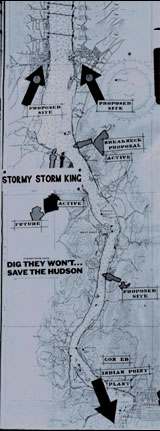JOURNAL ARTICLES
Barnthouse, L.W., J. Boreman, S.W. Christensen, C.P. Goodyear, W. Van Winkle, and D.S. Vaughan. “Population biology in the courtroom: The lesson of the Hudson River controversy.” Bioscience 34.1 (1984): 14-19.
This article focuses on the development of biology studies and their use in the courtroom. The authors are of the opinion that the Hudson River controversy acted as a catalyst for the development of much more sophisticated biology studies. As the Storm King case progressed, scientists had to come up with increasingly more complex and in-depth reports on the potential effects of the plants on fish, and more specifically bass, in the Hudson River. The studies progressed from reports, to charts, graphs, and drawings, to actual working models of what might happen in certain situations. Although the data was imperfect, these studies were still invaluable, and played a very important role in the settlement that ended the case. The authors believe that models and studies such as these will be increasingly used in more courtroom cases.
Buzzetto-More. “The Story of Black Rock: How An Early Sustainable Forest Spawned The American Environmental Movement and Gave Birth To a Unique Consortium That Links Science, Conservation, and Education.”
This article covers the history of Black Rock Forest , which was given as a gift to Harvard University from James Stillman. A portion of the forest was threatened by the Consolidated Edison plan to build a pumped-storage plant on Storm King Mountain . The author briefly recounts the Storm King Controversy, and the environmental movement that was spawned because of it. The rest of the paper focuses on the decision making progress that decided what would happen to the Black Rock Forest . Storm King Mountain was given over to the PIPC, but Harvard still had control over the rest of the forest. The land was eventually sold to what is now known as the Black Rock Forest Consortium, which is made up of dozens of schools, universities, and scientific institutions who use the land for scientific observation. The land is also open to the public on a daily basis.
“Dig They Must?” Newsweek 21 Dec. 1964 : 67-68.
This article gives a brief synopsis of what the Storm King controversy is about. It covers why the storage plant supporters are claiming the structure needs to be built, and it covers why its opponents are doing what they can to fight it. The article fairly gives examples from both sides of the argument, but in the end the magazine clearly gives its support to the opponents of the pumped storage plant.
Lifset, Robert. “ The Environmental is Political: The Story of the Ill-Fated Hudson River Expressway, 1965-1970.”
Tucker, William. “Environmentalism and the Leisure Class: Protecting birds, fishes, and, above all, social privilege.” Harper's Dec. 1977: 49-56, 73-80.
This article discusses the Storm King Mountain controversy from the side of the environmentalists, but takes the unique stance of interpreting the environmentalists' motives as selfish, and criticizing them for blocking the plant. The author maintains that the majority of the environmentalists were members of the wealthy “leisure class” who did not want Storm King built because it would destroy the view from their mountain estates. He claims that the pumped storage plant on Storm King was needed and would have been very useful for all the average citizens out there who needed power at more reasonable costs. The author claims that all arguments given by the opposition as to why Storm King should not be built were disproved, and that Scenic Hudson merely continued to search for new twists on old evidence so they could present “new evidence” and delay the project into the ground.
|


















